Submerged weeds are aquatic plants that grow entirely underwater, often rooted in the pond’s bottom. Submerged weeds include a variety of species, each with unique characteristics and growth patterns. They thrive in various water bodies, including ponds, lakes, and slow-moving rivers. Excessive growth of submerged weeds can hinder recreational activities like fishing, swimming, and boating. Uncontrolled weed growth can disrupt the ecological balance, impacting other aquatic plants and animals. Overgrowth can diminish the visual appeal of ponds and water features. Submerged pond weeds, while natural parts of aquatic ecosystems, can create challenges if not properly managed. This guide offers insights into effective control strategies, blending chemical, biological, and mechanical methods to maintain a healthy, visually appealing pond environment.
Identifying Common Submerged Pond Weeds
Characteristics of Submerged Weeds
- Growth Form: They typically have soft stems and are anchored to the pond bed, with most parts underwater.
- Leaf Structure: Leaves are often thin and ribbon-like, allowing them to move with water currents.
- Reproduction: Many reproduce quickly, either through seeds or fragmentation, leading to rapid spread.
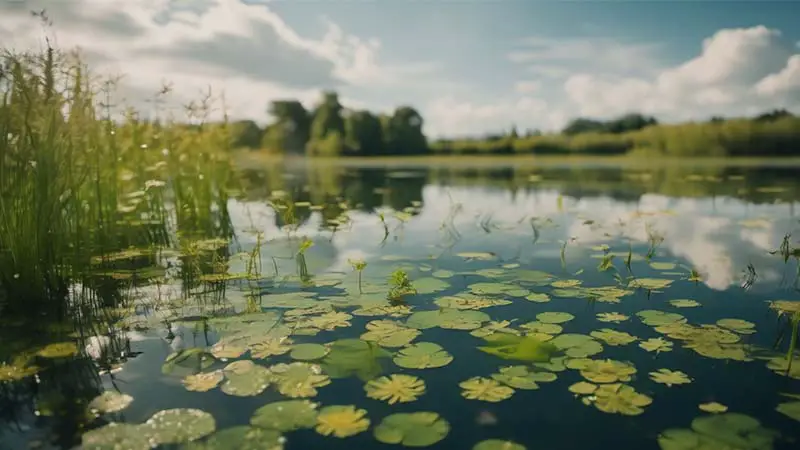
Examples of Common Submerged Weeds
- Coontail (Ceratophyllum demersum): Bushy, fan-like appearance with no true roots.
- Eurasian Watermilfoil (Myriophyllum spicatum): Feathery, whorled leaves and a distinctive reddish stem.
- Elodea (Elodea canadensis): Also known as waterweed, characterized by dense, leafy stalks.
The Impact of Submerged Weeds on Pond Ecosystems
Effects on Water Quality
- Oxygen Depletion: Decaying weeds consume oxygen, leading to lower levels which can stress fish and other aquatic life.
- Nutrient Imbalance: Dense weed growth can alter nutrient levels, affecting the growth of other aquatic plants.
- Water Clarity and Sedimentation: Decomposing weeds can increase sedimentation and reduce water clarity.
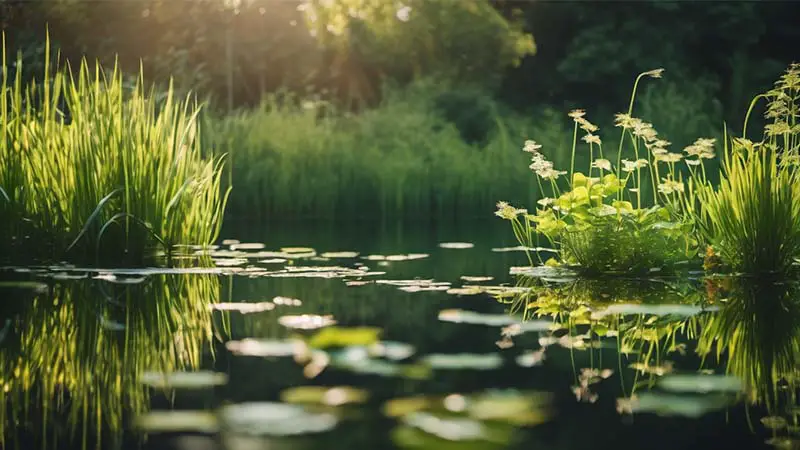
Impact on Aquatic Life
- Habitat Alteration: This can provide shelter for some aquatic organisms but may also overcrowd and disrupt habitats for others.
- Food Web Disruption: Excessive weed growth can alter the food web dynamics, impacting fish and invertebrate populations.
- Competitive Dominance: Dominant weed species can outcompete native plants, leading to reduced biodiversity.
This introduction and overview provide a foundation for understanding submerged pond weed control, their characteristics, and their impact on pond ecosystems.
Chemical Methods of Control
Types of Aquatic Herbicides
- Contact Herbicides: Target the parts of the plant they come into contact with, effective for quick results but may require reapplication.
- Systemic Herbicides: Absorbed by the plant and move within it, leading to complete destruction over time.
- Selective Herbicides: Target specific types of weeds, minimizing damage to non-target species.
- Non-selective Herbicides: Eliminate all plant life they come into contact with, used for severe infestations.
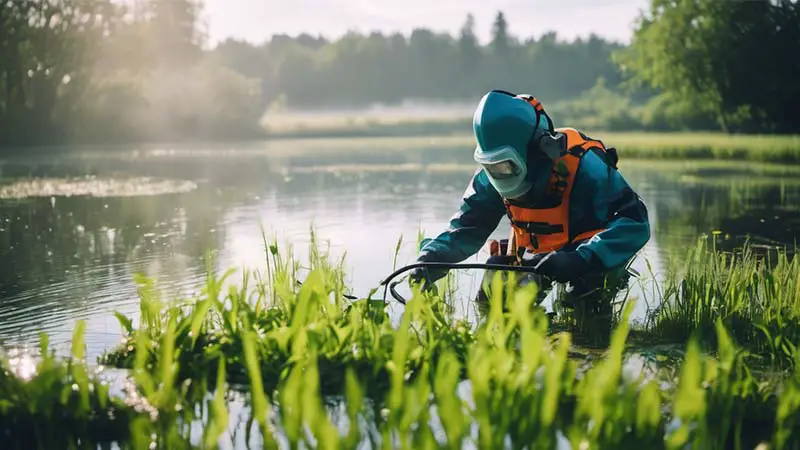
Safe Application of Herbicides
- Follow Label Instructions: Adhere strictly to the manufacturer’s guidelines for application rates and methods.
- Use Protective Gear: Wear appropriate safety equipment such as gloves, masks, and protective clothing.
- Environmental Considerations: Be aware of wind and water currents to avoid drift and contamination of non-target areas.
- Timing: Apply during optimal weather conditions and at specific growth stages of the weeds for maximum effectiveness.
Pros and Cons of Chemical Control
- Pros:
- Quick action against weeds.
- Effective for large-scale infestations.
- Cons:
- Potential harm to non-target plants and aquatic life.
- Possible environmental contamination.
- May require repeat applications for long-term control.
Biological and Natural Control Methods
Introducing Herbivorous Fish
- Species like Grass Carp: Effective in controlling certain types of submerged weeds.
- Stocking Rates: Must be carefully calculated based on the pond size and weed infestation level.
Using Beneficial Bacteria
- Nutrient Reduction: Consume excess nutrients in the water, reducing weed growth.
- Application: Added directly to the pond, often in pellet or liquid form.
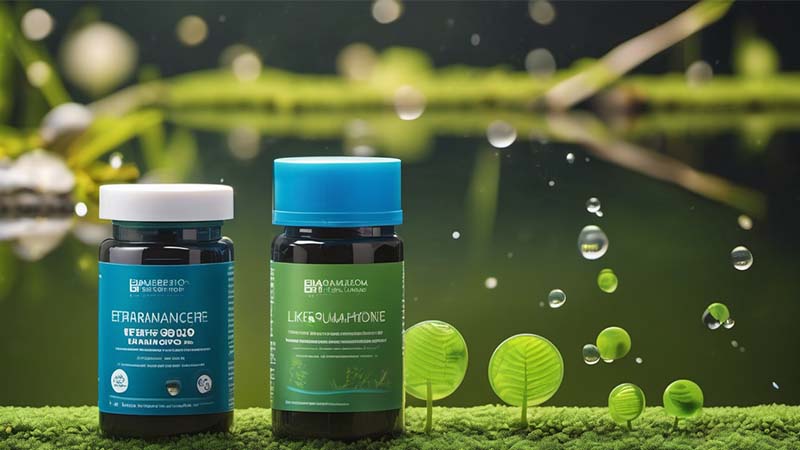
Pros and Cons of Biological Control
- Pros:
- Environmentally friendly and sustainable.
- Enhances the natural balance of the pond ecosystem.
- Cons:
- Takes longer to see results compared to chemical methods.
- Requires ongoing management and monitoring.
Mechanical and Manual Control Techniques
Tools for Mechanical Removal
- Weed Rakes and Cutters: Designed to physically remove or cut submerged weeds.
- Dredging Equipment: For large-scale removal, especially in deeper waters.
Best Practices for Manual Weed Removal
- Complete Removal: Ensure all parts of the weed, including roots, are removed to prevent regrowth.
- Regular Maintenance: Frequent checks and removals can prevent large infestations.
- Disposal: Properly dispose of removed weeds to prevent them from re-entering the pond or spreading to other areas.
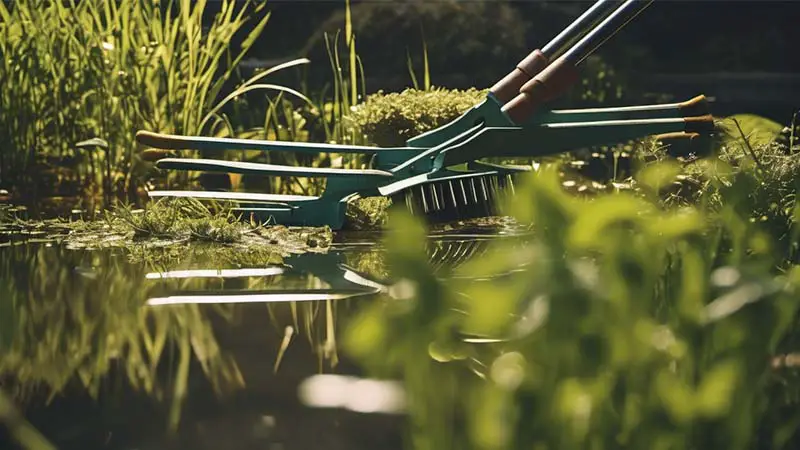
Advantages of Mechanical and Manual Control
- Environmentally Safe: No chemical use, thus no risk of contamination.
- Selective Removal: Allows for targeted removal of specific weeds without affecting others.
- Immediate Results: Visible improvement in the pond’s appearance and ecology.
Each of these methods has its own set of advantages and considerations, and often a combination of methods is the most effective approach for submerged pond weed control.
Preventative Measures and Pond Management
Aeration and Nutrient Control
- Aeration Systems: Use of fountains or aerators to increase oxygen levels, improving overall water quality and discouraging weed growth.
- Limiting Nutrients: Reducing the input of nutrients like nitrogen and phosphorus, which can be achieved by controlling runoff and using proper fertilizers around the pond.
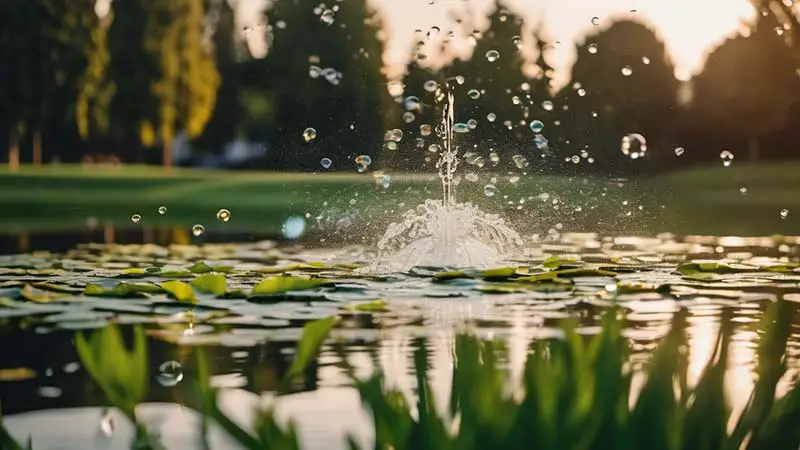
Regular Monitoring and Maintenance
- Early Detection: Regularly inspect the pond for early signs of weed growth for timely intervention.
- Maintaining Balance: Keeping a check on fish populations and other ecological factors to maintain a healthy pond environment.
Creating an Unfavorable Environment for Weeds
- Shading: Using pond dyes or floating plants to limit sunlight penetration, inhibiting photosynthesis in weeds.
- Water Level Management: Adjusting water levels at certain times of the year can disrupt the growth cycle of some submerged weeds.
Conclusion
In conclusion, effective submerged pond weed control requires a multifaceted approach combining various methods like chemical treatments, biological controls, and mechanical removal. Understanding the specific needs and conditions of your pond is crucial for selecting the right strategy. Regular monitoring and maintenance, along with preventive measures, play a significant role in keeping your pond healthy and weed-free. By implementing these strategies, pond owners can enjoy a balanced aquatic ecosystem that is both aesthetically pleasing and environmentally sustainable. Remember, patience and consistency are key in achieving long-term success in pond weed management.
FAQs on Submerged Pond Weed Control
1. What are the most effective methods for controlling submerged pond weeds?
- A combination of methods is usually most effective. These include mechanical removal, biological controls such as introducing herbivorous fish, and the use of aquatic herbicides. The choice depends on the specific type of weed, pond size, and environmental considerations.
2. Can I use fish to control submerged pond weeds?
- Yes, certain types of fish, like grass carp, are known to feed on specific submerged weeds. However, it’s important to choose the right fish species and quantity for your specific pond environment.
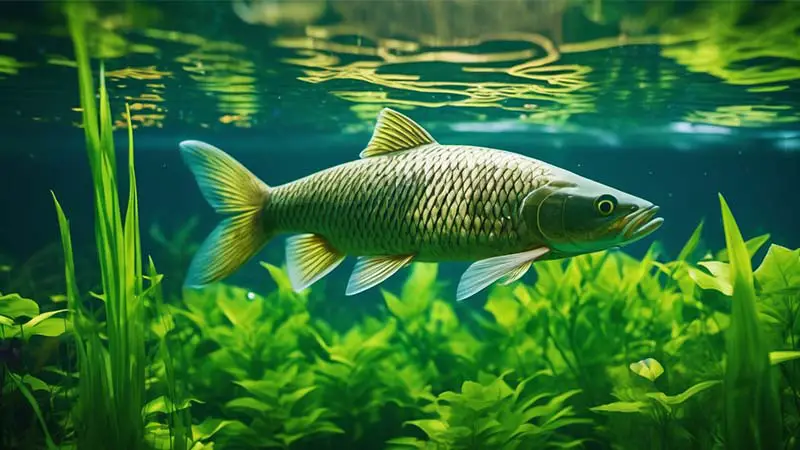
3. Are chemical herbicides safe for my pond and its inhabitants?
- Herbicides can be safe if used correctly and in accordance with the label instructions. Always choose herbicides that are approved for aquatic use and consider the potential impact on fish, beneficial plants, and the surrounding environment.
4. How often should I monitor my pond for weed growth?
- Regular monitoring is key. It’s recommended to inspect your pond at least once a month during the growing season to detect and manage any early signs of weed growth.
5. Can manual or mechanical removal completely eradicate submerged weeds?
- While manual and mechanical methods can significantly reduce weed presence, they may not completely eradicate them, especially if the root systems are not fully removed. Regular maintenance is often necessary.
6. What are some natural ways to prevent submerged weed growth?
- Natural prevention methods include maintaining a balanced ecosystem in your pond, using aeration to improve water quality, and managing nutrient levels to discourage weed growth.
7. Is it necessary to remove dead weeds after treatment?
- Yes, it’s important to remove dead plant material after treatment, as decaying plants can deplete oxygen in the water and contribute to further nutrient imbalance.
8. How does aeration help in controlling submerged pond weeds?
- Aeration improves oxygen levels in the water, which can help maintain a healthy pond environment less conducive to weed growth. It also helps circulate the water, reducing stagnant areas where weeds often thrive.
9. Are there any environmentally friendly herbicides for pond weed control?
- Yes, there are herbicides available that are designed to be environmentally friendly. Look for products specifically labeled as safe for aquatic environments and wildlife.
10. What should I do if I notice a sudden increase in weed growth in my pond?
- If you notice a sudden increase, it’s important to first identify the cause, which could be nutrient imbalances or changes in the pond ecosystem. Consulting with a pond management expert can help determine the appropriate course of action.
